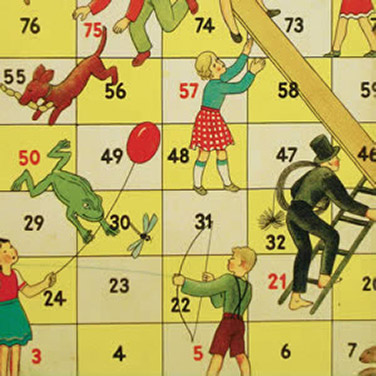Snakes and Ladders

Snakes and ladders is a classic race-based board game for two or more people. Each player throws a die and moves his or her piece the corresponding number of spaces. If you land on the bottom of a ladder, you climb up to a higher space. If you land on a snake’s head, however, you slide back down to the end of its tail. The winner is the first player to reach the finish by rolling the exact number of spaces required.
History
The direct ancestor of snakes and ladders is "moksha-patamu", an ancient Indian game with moral and religious connotations: the ladders were associated with virtues, the snakes with vices. The first game bearing the name "Snakes and Ladders" was published in England in 1892, featuring a spiral-shaped board with 100 spaces and snakes and ladders. Shortly afterwards, this was followed by the version still popular today with a square board and snaking course. In around 1920, a German edition was published by Spear & Söhne, which was known as "Auf und Ab! Lustiges Leiterspiel". The snakes were replaced by all manner of fanciful scenes with children playing or animals, and the symbolic character of the game faded into obscurity.
Mathematics
Dice-based races beg the question as to how long, on average, a piece needs to cover a certain distance. This kind of calculation is particularly complicated if a piece can drop back down. On a board with 100 spaces, snakes and ladders can be considered as a Markov chain with 101 states, which enables the expected value for the game's duration to be calculated. In 1960 N.W. Bazley and P.J. Davis published a study on snakes and ladders based on the Monte Carlo method, where the average number of dice rolls a player needs to reach the finish is calculated. The result is an approximation of 39.22 moves.